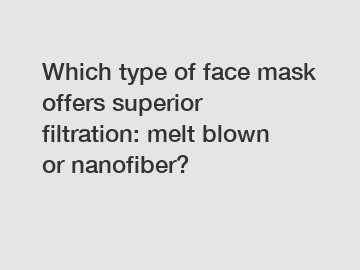Which type of face mask offers superior filtration: melt blown or nanofiber?
Which type of face mask offers superior filtration: melt blown or nanofiber?
With the ongoing COVID-19 pandemic, face masks have become an essential accessory for people around the world. Their primary function is to protect individuals from inhaling harmful particles, including virus particles, suspended in the air. When it comes to face masks, there are various types available, each offering different levels of filtration efficiency. In recent times, two types of masks have gained immense popularity for their superior filtration capabilities – masks made from melt blown and nanofiber materials. Let's explore these two options to determine which one offers superior filtration.
Melt blown face masks.

Melt blown masks have been widely used in healthcare settings and are also commonly referred to as surgical masks. These masks are made by using a melt blowing process where thermoplastic polymers are melted and extruded through small nozzles to form microfibers. The fibers are then collected on a conveyor belt, forming a non-woven fabric that is later used to construct masks.
The filtration efficiency of melt blown masks depends on the size of the fibers and the density of the fabric. These masks are designed to capture larger particles such as droplets, dust, and pollen. However, they may not be as effective in capturing smaller particles, such as viruses. The ability to capture small particles is measured by the mask's particle filtration efficiency (PFE), which is generally lower in melt blown masks compared to masks made from nanofibers.
Nanofiber face masks.
Nanofibers are ultrafine fibers with diameters ranging from a few hundred nanometers to a few micrometers. Unlike melt blown masks, nanofiber masks are made using electrospinning techniques, which involve the action of an electric field on a polymer solution or melt. This results in the formation of nanofibers with a much higher surface area, allowing for enhanced filtration capabilities.
Nanofiber masks offer several advantages over melt blown masks. Due to their smaller fiber diameter, nanofiber masks can effectively capture a wider range of particle sizes, including smaller particles like viruses and bacteria. Additionally, the high surface area of nanofiber masks allows for increased pore density, leading to better filtration efficiency. Studies have shown that nanofiber masks can achieve filtration efficiencies as high as 99%.
Comparing melt blown and nanofiber masks.
When it comes to filtration efficiency, nanofiber masks clearly outperform melt blown masks. Nanofiber masks are effective in capturing a broader range of particle sizes, including smaller particles like viruses. The higher filtration efficiency offered by nanofiber masks makes them a preferred choice for individuals seeking maximum protection against airborne contaminants.
However, it is essential to consider other factors as well, such as breathability and cost. Nanofiber masks tend to be more breathable due to the smaller size of the fibers, which allows for better air circulation. On the other hand, melt blown masks may be more cost-effective and readily available compared to nanofiber masks.
In conclusion, while both melt blown and nanofiber masks provide filtration, nanofiber masks offer superior filtration efficiency, especially when it comes to capturing smaller particles like viruses. However, the choice between the two depends on individual preferences, including factors such as breathability and cost. It is crucial to choose a mask that best suits one's needs and provides adequate protection.
For more information or to find the right face mask for you, please don't hesitate to contact us.
Keywords: face mask, filtration, melt blown, nanofiber, COVID-19, virus particles, particle filtration efficiency, breathability, cost.
For more kn100 class duckbill shaped mask, oem safety helmet, kn100 mask supplierinformation, please contact us. We will provide professional answers.


